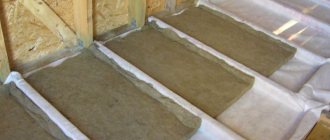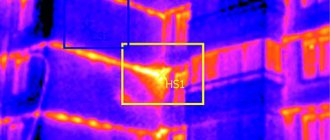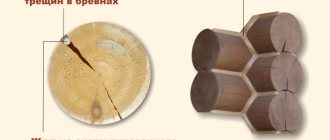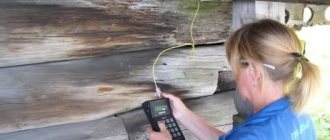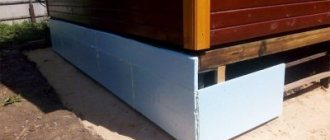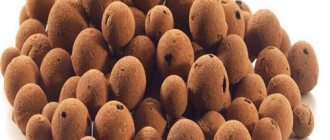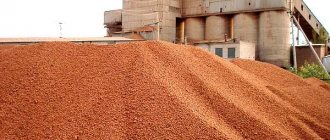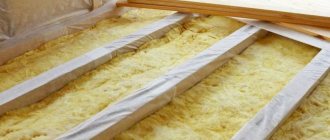When building a private cottage, country house or any public building, the main task is to minimize the heat loss of the facade. This leads to lower costs for various fuels, be it gas or wood. To achieve this, various types of insulation are used. The most affordable option is to insulate various walls with expanded clay.
Expanded clay in bulk
Choice of material and which fraction is better
To understand how to retain heat and insulate walls with expanded clay, it is necessary to understand the very understanding of this material.
The concept of “expanded clay” is a collective term and implies the presence of insulation in several varieties. But they are all united by some common points. First of all, these are raw materials for production. It is represented by gravel in three fractions, sand and crushed stone.
Gravel
It looks like round or oval granules. It is obtained by firing clay, and the place of production is rotary kilns. Gravel has various uses, which is determined by the diameter of its fraction:
- 20-40 mm. In this form it has the lowest bulk density. It is used where a thick layer of thermal insulation is required. It is mainly used for filling foundations, attic floors, and cellars.
- 10-20 mm. This insulation is used for floors, roofs, and walls if they are made using the well masonry method.
- 5-10 mm. It is mainly used as a base for “warm” floors. In addition, they insulate exterior facades. A mixture of cement and expanded clay is poured between the masonry and the cladding.
Varieties of expanded clay
Sand
It is obtained by sifting out fine clay. In addition, large pieces of expanded clay are crushed in shaft furnaces. The scope of application depends on the size of the fraction:
- Expanded clay sand with a fraction of up to 5 mm is used to make a cement floor screed, where the layer thickness can reach up to 20 cm;
- sand with a fraction of up to 3 mm is used to obtain “warm” masonry mortar.
Crushed stone
It is obtained by crushing large pieces of baked clay. It is used as a thermal insulation filler when producing concrete structures that have a lower specific density.
Expanded clay of different fractions
To choose the right expanded clay, you need to pay attention to the following characteristics:
- Ability to insulate heat and sound. What matters is the thermal conductivity coefficient that the granules have. Heat is best retained in the presence of granules with low thermal conductivity. Expanded clay granules with a diameter of 10-20 mm are the best option when bulk heat-insulating materials are used. With their use, the amount of heat loss is significantly reduced.
- Bulk density value. If it is necessary to equip the foundation, then the density of the granules is of great importance. It depends on many factors. The most significant of them is the quality of the raw materials. The rules for observing the technological process during heat treatment of granules in ovens are important. Various additives can be used to enhance strength.
- Ability to absorb moisture. The material must have a correlation coefficient of at least 0.46. If the indicator is lower, then the granules absorb and retain moisture. This is evidence of poor product quality.
- Resistance to putrefactive processes and fungal infection. If the material is affected by fungus and rot, this indicates that low-quality additives were used in production. Such expanded clay cannot be used for wall insulation.
- Resistant to fire. The use of expanded clay not only insulates the house, but also increases its fire safety.
Based on these data, you can choose the ideal option for a certain type of work related to insulating the walls of a building.
Expanded clay
Expanded clay is a loose insulation material in the form of porous round granules consisting of low-melting clay and shale. The material is obtained by firing a clay-shale mixture to a temperature of 1050°C for half an hour.
When the clay heats up, it swells and voids form in it. If the technology is not violated, porous granules are formed as a result of cooling of the raw material. Their round shape is due to the rotational movements in the oven.
Compared to other types of thermal insulation, expanded clay has a longer service life. In addition, the cost of expanded clay is significantly lower than the cost of other insulation materials.
How much material will be needed: how to calculate
Building a house involves large financial costs, and naturally, if there is an opportunity to save money, it is worth taking advantage of. To do this, you will need to correctly calculate the required volume of insulation so as not to overpay for what is unnecessary.
When making calculations, the thickness of the expanded clay should be taken into account. The thermal conductivity coefficient depends on this. On average, for effective insulation, the layer thickness should be 10 cm. Then you will need 1/3 of the cube. You can see how many kilograms of expanded clay are included in one cube on the packaging, approximately from 15 to 800 kg, depending on the type. If your expanded clay weighs 300 kg, then 1 cubic meter will require 60 kg.
Expanded clay is packaged and sold in bags
The cost of expanded clay also depends on its type. The smaller the fraction, the higher the price. On average, the cost varies from 1700 to 2800 rubles. For the bag.
Advantages of expanded clay as insulation
This material has a number of positive qualities that contribute to its active use in the construction industry:
- Environmentally friendly. It is made from natural raw materials, so its use is considered safe.
- Affordability. The low cost makes this material very popular and profitable in home construction.
- Convenient to use. Due to their small size, the granules can fill any gaps.
- Light weight does not put a load on the foundation.
- Due to its good technical characteristics, it is able to withstand temperature changes, thanks to which it is used in different climatic zones.
The advantages also include the material’s resistance to rotting and does not attract rodents and insects. Its use will allow you to keep heat in the house for a long time and reliably.
Advantages and disadvantages of expanded clay
Let's analyze the pros and cons of expanded clay insulation. The advantages of this insulation include:
- safety from an environmental point of view;
- financial inclusion;
- excellent sound insulation qualities;
- long service life;
- resistance to frost and temperature changes;
- a light weight;
- strength;
- fire resistance;
- good thermal insulation properties.
The disadvantages are considered to be high hygroscopicity and the need to use a fairly large volume of material for high-quality insulation.
Preparatory work
Before installing the insulation, it is necessary to lay waterproofing. It will protect expanded clay from excess moisture. To do this, you can use regular plastic film. After laying it, the edges are fixed with construction tape.
It is better to use expanded clay when insulating a new building, when its construction is just underway. In this case, three-layer masonry is used. Each layer is associated with certain characteristics. The load-bearing layer is made using expanded clay concrete blocks with a thickness of 20 to 40 cm. For the main layer, granulated expanded clay and cement laitance are used. The last layer is represented by wooden, panel or brick protection.
Before laying the heat insulator, it is doused with cement laitance. At the same time, individual fractions set faster, and as a result, the entire layer as a whole hardens faster. Installation requires many tools. The work is carried out using a trowel, which is used by masons, a mortar shovel, a hammer, and a chisel. When performing work, you cannot do without levels and plumb lines, and a measuring tape. In addition, it is necessary to prepare a container in which the solution is mixed.
Types of expanded clay
Let's consider the types of expanded clay and choosing the best one for insulation. Based on the size and shape of the granules, the building material is divided into:
- expanded clay sand;
- expanded clay crushed stone;
- expanded clay gravel.
The production process for all mentioned varieties is the same. The difference lies in the use - different types are used in different jobs.
Techniques for insulating a mill with expanded clay
The following materials are required for the work: sand, cement, expanded clay screenings and reinforcing mesh.
Fine-fraction expanded clay for wall insulation
As soon as the method by which the heat insulation will be laid is chosen, the thickness of the backfill is determined. Professionals recommend having some reserve. This achieves an increase in the sound and heat insulation that the wall will have.
When building a private house, well masonry is mainly used. With it, a layer of insulation is located between the inner and outer walls in the middle part of the masonry.
Using expanded clay for wall insulation
With this type of insulation of the walls of a brick house with expanded clay, the masonry is not thick, but has good performance related to thermal conductivity. In this case, less materials are consumed for construction. But this requires accurate calculations of the work in which diaphragms are performed.
Condensate liquid may accumulate inside the well. To prevent this, the inner surface is covered with a vapor barrier layer. Assembled when performing such work, the entire wall can have a thickness of 30 to 60 cm.
The masonry is simple and is carried out according to the following algorithm:
- the foundation is completed. These are the two bottom rows of bricks. Before laying them on the foundation, a horizontal layer of waterproofing is performed;
- carry out the construction of external parallel walls and partitions for their connection (diaphragm);
- When 5-6 rows have been completed, insulation is poured into the well. After this, it must be compacted thoroughly. Filling is carried out exclusively with dry gravel and is done in layers. The insulation is poured on top with a cement-based solution;
- Before backfilling, a sheet of foam plastic with any waterproofing is placed down. This will not allow the material to absorb moisture from the surface of the earth and remain dry from the inside;
- then a concrete screed is performed. It serves to give greater rigidity;
- then carry out the execution of horizontal diaphragms;
- The construction of the wall continues in this manner until the end.
We also recommend that you read the link svetokna.ru. The company produces PVC windows, doors, balconies and loggias.
Insulation options
Expanded clay can be laid in three ways:
Dry method
In this case, the expanded clay insulation technology consists of pouring insulation between the joists. A subfloor made of boards or plywood sheets is mounted on top.
To protect the base from moisture, a layer of waterproofing is laid under the material. This insulation option is distinguished by its speed and ease of execution.
Wet method
The photo of expanded clay insulation shows that with this method, the insulation is mixed with concrete mortar and then the space between the beacons is filled with this mixture.
Combined method
This method consists of pouring dry expanded clay into the space between the joists, leveling it and soaking the top layer with cement mortar. After this, a leveling screed is made.
The cement mixture strengthens the expanded clay layer, helping to avoid deformation during subsequent pouring of the screed. If necessary, it is appropriate to use reinforcing mesh.
Finishing
After completing the insulation work, the wall will dry within a few days. The final strength gain will be completed in a month. Then finishing and cladding are performed. For finishing you can use brick or wood. Before this, the walls are plastered. This is done both externally and internally. This achieves additional insulation from steam and moisture. The outer plaster layer will protect the building from precipitation. In addition, the structure is given greater rigidity.
In order to prepare the solution, river sand and cement (M400) are mixed in a ratio of 4:1. The final finishing can be done with decorative stone. This is a pretty good solution. They can perform work not only outside, but also inside the building. This is a good interior solution without putting significant additional pressure on the structure. Such material should be free of visible stains and growths. It will be even better if the outer surface is coated with a water-repellent composition.
Insulation of brickwork with expanded clay
At a relatively low cost, expanded clay is very popular as insulation. Having completed such work, the house will be warm and comfortable. But at the same time, it is necessary to control the load indicators on the foundation and the structure as a whole. Otherwise, insulating a house with expanded clay is considered a profitable option. This serves as one of the indicators of its wide popularity. It should also be said that the work associated with insulating a private house with expanded clay is not particularly difficult.
Insulation of brick walls with expanded clay - technology
Expanded clay is a loose type of insulation. This means that it is poured into a specially created frame. Therefore, this method of insulation is good for walls made of three layers. There is an important point in the work - you need to fill in the expanded clay in stages, gradually, as the masonry grows. If you fill up material from the roof when the wall is ready, the insulation effect will not be the same. Let's look at several ways to carry out the work.
Option 1 - light well masonry
Insulation of walls with expanded clay, light well masonry technology is as follows: 2 layers of wall brick construction or bricks with blocks are laid in rows. A distance of 15 to 30 cm is maintained between them. There is a pattern - the colder it is in the region, the wider the distance between the rows becomes.
After one or two rows, the masonry is tied with brick lintels along the entire thickness of the wall at a distance of 50 to 70 cm. As the structure grows, wells will form into which expanded clay is poured every 30–50 cm. It is compacted to improve performance and prevent shrinkage. This must be done carefully so as not to damage the granules. To bind expanded clay, you can pour it with cement laitance. This is the name of a liquid cement mortar. Then the shrinkage of expanded clay will be minimized.
Option 2 – well masonry with rigidity diaphragms
This is the best option for insulating brickwork. To implement it, you need to lay out wall strips outside and inside, the thickness of which will be equal to 1 and half a brick. To make the house also attractive, the outer row or band can be made of facing bricks. This is also done from ceramic block, concrete blocks for further plastering, or from white brick (silicate).
The step between the outer and inner tape remains the same as in the first case - from 10 to 30 cm. To make the box more rigid, the corners are made solid. Expanded clay is poured into the space. This is done at intervals of five rows of brick laying. As in the first case, the raw material is compacted and filled with milk. Then you need to lay out a brick stiffening diaphragm along the entire thickness of the wall. Why is this necessary? To make the structure more rigid in height without resorting to the use of dressing anchors.
Important! The disadvantage of this method is that it will be impossible to get into the created pockets with expanded clay. And if during operation the insulation settles after insufficient compaction, then it will not be possible to fill the resulting space.
Option 3 – treasure using embedded parts
This option resembles the first described method. The exception is that instead of brick lintels, metal or fiberglass anchors are inserted into the masonry. This is done at a distance of 40 to 60 cm. This allows you to reduce the consumption of bricks and not have to resort to calculating steps to build the masonry. With all this, the strength characteristics of the masonry remain at the same level. Expanded clay should be poured to the same 30–50 cm. This volume will make it easier to compact and saturate the layer with cement laitance.
We looked at the insulation of walls with expanded clay during their construction. This is an effective way to make them warmer for little money. And taking into account how many advantages this insulation has, there is no doubt that with the right technology, the house will remain warm and cozy for many years.


